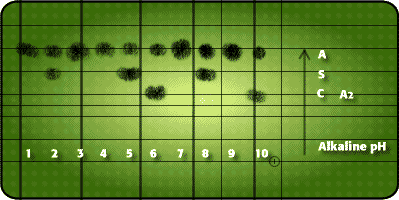KNOWLEDGE TEST
Assess how much you really know about Sickle Cell Disease by answering the questions below.
KNOWLEDGE TEST - Which ones are'True' or 'False'
1. Sickle Cell Disease..
- Is acquired by long stay in the Tropics.
- Is inherited from either father or mother, not both.
- Occurs when both parents pass on abnormal haemoglobin genes, at least one of which is the sickle gene.
- Confers immunity against malaria.
- Does not occur in white people.
- Cannot occur when only one parent has the sickle gene.
- Is so serious no patient has attained 60 years of age.
- Is known as sickle cell anaemia only when both parents pass on a sickling gene i.e. S from father, S from mother, making "SS".
- Diagnosis is not compatible with a haemoglobin level of 15 gram/dl (Normal range 13.2-17.0 male; 11.5-15.5 female).
- Patients seldom go through life without regular blood transfusion.
2. The term..
- Homozygous means inheriting similar genes from both parents e.g. AA, or SS, or CC, or TallTall, or Short-Short.
- Heterozygous means inheriting dissimilar genes from both parents provided one gene is normal i.e. A (normal) & S (abnormal), or AC, or AD, or AE.
- Heterozygous means inheriting dissimilar genes from parents irrespective of whether one of the pair is normal or not i.e. AS, SC, CD, SO.
- Double heterozygote state is when the two dissimilar genes are abnormal, like SC, SD, SBetathal.
- Genotype refers to the pair of genes inherited from both parents for the same characteristic. If father gives haemoglobin S gene and mother haemoglobin C gene to a child then the genotype for haemoglobin production is SC.
- Phenotype, used sometimes interchangeably with genotype, means what the genotype produces.
- Mendellian Dominant refers to a gene that reveals itself once it is present in a pair of dissimilar genes.
- Mendellian recessive refers to a gene that reveals itself only when present in a double 'dose'.
- Sickle Cell Trait is interchangeable with Sickle Cell Disease.
- Sickle Cell Trait means the possession of one normal gene for haemoglobin formation (A) and the abnormal sickle gene (S), with the proportion of A always exceeding that of S.
3. In normal human haemoglobin..
- Haemoglobin A2 consists of two alpha polypeptide chains and two gamma polypeptide chains.
- Haemoglobin F has two alpha and two beta polypeptide chains.
- Haemoglobin A has two alpha and two delta polypeptide chains.
- Haemoglobin A2 is usually less than 4% of total haemoglobin.
- Haemoglobin F seldom disappears before 2 years of age.
4. In alpha thalassaemia..
- There is suppression of alpha chain synthesis.
- There is enhancement of alpha chain synthesis.
- Only adult haemoglobin A formation is affected.
- Hydrops foetalis is sometimes a feature.
- High foetal haemoglobin (F) levels are always found.
5. Glucose-6-phosphate dehydrogenase (G6PD) deficiency..
- Is an acquired condition produced by ingesting primaquine and similar drugs.
- Is not acquired but inherited as a recessive condition.
- Is inherited as a Mendellian Dominant.
- Is found in nearly 25% of Ghanaians only after severe exercise.
- May be passed on from mother to son but not from father to son.
6. The Sickling Test
- When Positive means the person is a sickler.
- When Positive means the person has sickle cell disease.
- When Negative means there is no abnormal haemoglobin present.
- When Positive can tell sickle cell trait from sickle cell disease.
- Is very rarely Positive when there is no haemoglobin S.
- Is complicated, needing sophisticated equipment.
- Must be performed on all Black people before general anaesthesia.
- Is Positive in nearly 20% of some Southern Turks, 40% of certain parts of Saudi Arabia, 16% of people in Southern Iraq, one in 4 of the Lebanese Allewits, 1% of Soviet Azerbajan, and 43% of the Indian Praja Paraja.
- Is not necessary when a more sophisticated test like Haemoglobin Electrophoresis is available
- Can be performed without reagents.
7. Haemoglobin Electrophoresis..
- Enables haemoglobins to be separated but the process takes more than 24 hours.
- In alkaline pH shows normal haemoglobin A faster than sickle haemoglobin S with haemoglobins A2 and C midway between haemoglobins A and S.
- Reveals a reduced haemoglobin A2 level in betathalassaemia but a raised level in alphathalassaemia.
- Is definitely conclusive in clinching the diagnosis of sickle cell anaemia (SS) without clinical examination of the patient and doing family studies.
- Can diagnose abnormal haemoglobin disease which is not sickle cell disease.
- Pattern showing two major bands, at A and S means sickle cell trait.
- Shows a betathalassaemia band whenever a betathalassaemia gene is present.
- Alone should not be used in genetic counselling.
- May hide many different haemoglobins in the same band.
- At more than one pH solution is often required to tell haemoglobins apart.
8. The Sickle Cell Crisis..
- Cannot be diagnosed without laboratory tests.
- Is almost always due to a change in the body's internal environment.
- Should get more frequent as the patient gets older than 20 years of age.
- Can take the form of haemolysis, bone marrow suppression, sequestration of sickled cells in abdominal organs like the spleen and liver, but never a combination of these together.
- Can be precipitated by sore throats and/or urinary tract infection.
- Can present as acute low backache and joint pains without eyes getting yellow.
- May be confused with acute appendicitis.
- Can often cause numbness of the upper lip.
- May be heralded by changes in weather.
- Is seldom caused by malaria.
9. In the Management of the Sickle Cell Disease Patient
- Doctors, nurses, social workers, and parents are together the best team, with doctors by far the most important.
- Anticipation of symptoms is less important than prompt treatment once symptoms arise.
- Fluid and salt intake must be reduced in cold weather in order not to overload the circulation.
- Periodic attention to teeth and throat is needed with careful records.
- Regular blood transfusion gives better results than "transfusion only to save life".
- Epistaxis (nose bleeding), haematuria (blood in the urine), priapism in the male (persistent erection), should always be considered due to the sickling process alone.
- Control of pain in sickle crisis is the most important requirement.
- Dehydration in children from diarrhoea and vomiting may precipitate death in hours.
- Sudden blindness in one eye in a Black youth should usually draw attention to the SS phenotype.
- Complications in pregnancy may call for partial exchange blood transfusion.
10. In Genetic Counselling
- The main aim is to prevent the marriage of traits, or of traits to people with a sickle cell disease phenotype.
- A haemoglobin C trait man (AC) marrying a sickle cell haemoglobin C disease lady (SC) should know that one quarter of the children would be expected to have abnormal haemoglobin disease.
- A non-sickling man could not be the father of a child whose haemoglobin electrophoresis is reported on as "SS".
- The levels of haemoglobin A and S require to be measured before a 'diagnosis' of sickle cell trait AS can be made.
- When the husband in a happy marriage is found to have the SC phenotype but all the 3 children are found to be AA the best thing to do, after repeating the tests, is to ignore the results.
GENETIC COUNSELLING
A man whose blood had been tested on several occasions and found to be sickling Negative had 5 children by his first wife. All the children were diagnosed 'AA' through haemoglobin electrophoresis. His second marriage produced 3 children, the first two of whom had the sickle cell trait (AS), but the third was found to have sickle cell haemoglobin C (SC) disease.
The man, indignant, disowned the child and accused the woman of infidelity. Indicate clearly by careful reasoning whether or not the man's claim that the woman had committed adultery can be substantiated.
Study the haemoglobin electrophoretic strips and answer the following questions:
- What names would you give electophoretic patterns 1 to 10? [eg AC? CA? AA? etc].
- What diagnosis would you provisionally assign these patterns when you are informed that the "S" band is indeed a sickling haemoglobin, and the "C" band is indeed haemoglobin C, and not E or O?
- What are the expected phenotypes resulting from matings
- between No.2 (female) and No.10 (male)?
- between No.2 (female)and No.8 (male)?
- between No.2 (female)and No.7 (male)?
- between No.5 (female)and No.8 (male)?
- between No.5 (female)and No.10 (male)?
- between No.6 female)and No.10 male)?
- between No.1 female)and No.10 (male)?
- between No.6 female)and No.8 (male)?
- between No.4 (female) and No.9 male)?
- between No.4 (female) and No.10 (male)?


